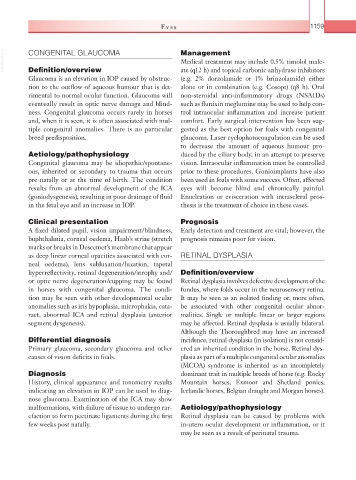Page 1184 - Equine Clinical Medicine, Surgery and Reproduction, 2nd Edition
P. 1184
Eyes 1159
VetBooks.ir CONGENITAL GLAUCOMA Management
Medical treatment may include 0.5% timolol male-
Definition/overview
Glaucoma is an elevation in IOP caused by obstruc- ate (q12 h) and topical carbonic anhydrase inhibitors
(e.g. 2% dorzolamide or 1% brinzolamide) either
tion to the outflow of aqueous humour that is det- alone or in combination (e.g. Cosopt) (q8 h). Oral
rimental to normal ocular function. Glaucoma will non-steroidal anti-inflammatory drugs (NSAIDs)
eventually result in optic nerve damage and blind- such as flunixin meglumine may be used to help con-
ness. Congenital glaucoma occurs rarely in horses trol intraocular inflammation and increase patient
and, when it is seen, it is often associated with mul- comfort. Early surgical intervention has been sug-
tiple congenital anomalies. There is no particular gested as the best option for foals with congenital
breed predisposition. glaucoma. Laser cyclophotocoagulation can be used
to decrease the amount of aqueous humour pro-
Aetiology/pathophysiology duced by the ciliary body, in an attempt to preserve
Congenital glaucoma may be idiopathic/spontane- vision. Intraocular inflammation must be controlled
ous, inherited or secondary to trauma that occurs prior to these procedures. Gonioimplants have also
pre-natally or at the time of birth. The condition been used in foals with some success. Often, affected
results from an abnormal development of the ICA eyes will become blind and chronically painful.
(goniodysgenesis), resulting in poor drainage of fluid Enucleation or evisceration with intrascleral pros-
in the fetal eye and an increase in IOP. thesis is the treatment of choice in these cases.
Clinical presentation Prognosis
A fixed dilated pupil, vision impairment/blindness, Early detection and treatment are vital; however, the
buphthalmia, corneal oedema, Haab’s striae (stretch prognosis remains poor for vision.
marks or breaks in Descemet’s membrane that appear
as deep linear corneal opacities associated with cor- RETINAL DYSPLASIA
neal oedema), lens subluxation/ luxation, tapetal
hyperreflectivity, retinal degeneration/ atrophy and/ Definition/overview
or optic nerve degeneration/cupping may be found Retinal dysplasia involves defective development of the
in horses with congenital glaucoma. The condi- fundus, where folds occur in the neurosensory retina.
tion may be seen with other developmental ocular It may be seen as an isolated finding or, more often,
anomalies such as iris hypoplasia, microphakia, cata- be associated with other congenital ocular abnor-
ract, abnormal ICA and retinal dysplasia (anterior malities. Single or multiple linear or larger regions
segment dysgenesis). may be affected. Retinal dysplasia is usually bilateral.
Although the Thoroughbred may have an increased
Differential diagnosis incidence, retinal dysplasia (in isolation) is not consid-
Primary glaucoma, secondary glaucoma and other ered an inherited condition in the horse. Retinal dys-
causes of vision deficits in foals. plasia as part of a multiple congenital ocular anomalies
(MCOA) syndrome is inherited as an incompletely
Diagnosis dominant trait in multiple breeds of horse (e.g. Rocky
History, clinical appearance and tonometry results Mountain horses, Exmoor and Shetland ponies,
indicating an elevation in IOP can be used to diag- Icelandic horses, Belgian draught and Morgan horses).
nose glaucoma. Examination of the ICA may show
malformations, with failure of tissue to undergo rar- Aetiology/pathophysiology
efaction to form pectinate ligaments during the first Retinal dysplasia can be caused by problems with
few weeks post natally. in-utero ocular development or inflammation, or it
may be seen as a result of perinatal trauma.

